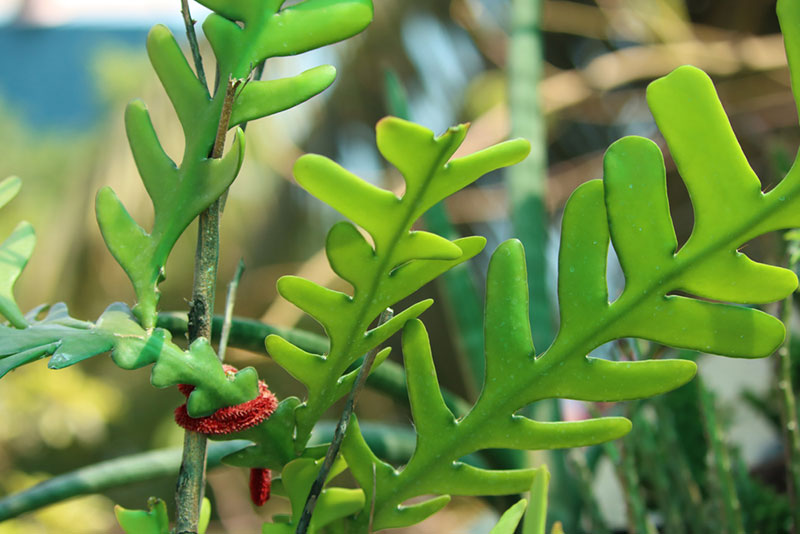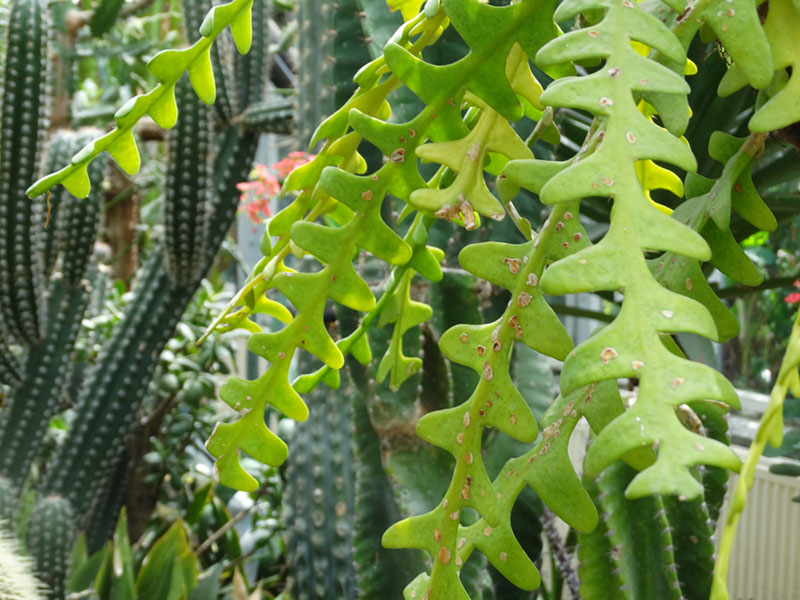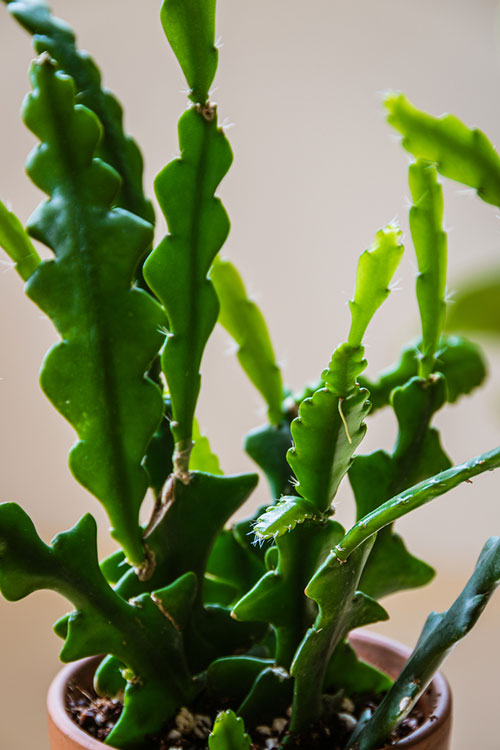
The fishbone cactus (Epiphyllum ‘anguliger’) isn’t your ordinary desert cactus. This cactus is an epiphytic cactus that lives in organic matter (such as decaying leaves) that gathers between the branches of mature trees in humid, tropical forests. It is native to mountainous areas of Mexico.
The fishbone cactus is similar to an orchid plant when it comes to its growing needs. In fact, it is often referred to as a zig zag or ric rac orchid cactus. What looks like leaves on the fishbone cactus are actually flattened elongated stems that look like the backbone of a fish that arch gently over the side of pots and containers.
Fishbone cactus are typically grown as houseplants, but you can put them outside in the summer if you prefer. Place them in a shaded area that receives bright light, but avoid putting them in direct sunlight as it can damage the plant.
Light and Temperature Requirements
In nature, the fishbone cactus grows in the understory of trees and receives indirect light. Its flattened stems have developed to harness and use sunlight in low-light conditions. While it can tolerate short bursts of direct sunlight during the day, it should be placed in a location where it receives bright, indirect light. You can accomplish this by placing it 2 to 3 feet from a sunny window or use sheer curtains between the plant and the window to reduce the amount of direct sunlight that falls on the plant.
Attention should be given to room temperature, too. The fishbone cactus prefers temperatures between 60 and 78 degrees and will suffer if the temperature drops below 50 degrees. Avoid placing them in areas that receive cold drafts or bursts of heat from your heater in the winter.
Fishbone cactus prefer humid conditions and may do best in the kitchen or bathroom where humidity tends to be highest. Otherwise, group them with other plants on a pebble tray filled with water in the winter to prevent dry air around the plants.

Watering
The fishbone cactus requires more watering than desert cactus, but it can be picky, too. Either over or under watering can cause the fleshy stems to get mushy and collapse. As a rule, water your fishbone cactus when the top two inches of soil in the plant pot has dried.
It is important to water your fishbone cactus with water at room temperature as their roots are sensitive to cold water. Likewise, they can be sensitive to chemicals in municipal water. Fill a watering can with tap water and allow it to sit for 24 hours to allow any additives to dissipate and for the water to reach room temperature.
Water you fishbone cactus until water runs freely through the bottom of the pot and then allow it to dry out before watering it again. Do not leave standing water in the saucer after watering your fishbone cactus. Reduce watering in the winter.
Soil & Fertilizing
The fishbone cactus prefers loose soil that drains well, but cactus and succulent mixes may be too heavy for it. Mix one part perlite and one part peat moss to one part commercial cactus soil to make the ideal soil for the fishbone cactus.
Fertilize fishbone cactus with liquid fertilizer labeled for cacti and succulents following the recommended application rate.
Deadheading and Pruning
The fishbone cactus require very little grooming, but can be pruned to maintain the size and length of the arching stems when desired. Simply trim the arching branch to the desired length with a sharp knife or scissors. This generally causes new branches to form below the cut.
This cactus does bloom and produces a highly-fragrant, yellow bloom that is several inches long. The flowers typically appear in late fall or early winter and open only at night. This showy bloom only lasts for one day. If you are lucky enough to see buds forming on your fishbone cactus be alert to check it at night to see its amazing flowers.

Propagation
Fishbone cactus are relatively easy to propagate via stem cuttings. Here’s what you need to know.
- Cut the stem at the base of one of the arching branches and trim it to a length of 4 inches.
- Place the cuttings in a cool, dry location for two weeks to allow the cut edge to callous over.
- Fill a 4-inch pot with pre-moistened potting mix.
- Place 4 cuttings in the pot and firm them into the soil with your hands.
- Place the pots in a location that receives filtered light.
- Mist the plants and soil every few days to maintain moisture and humidity.
- Transplant the new plants to their permanent containers when you see signs of new growth and then resume normal care.
The fishbone cactus looks best when grown so that it’s arching, fishbone-shaped stems have plenty of room to grow. Consider growing it in a hanging basket or in a pedestal style plant pot. It can also be grown in a regular plant pot on a plant stand where the arching branches have room to cascade over the sides.




